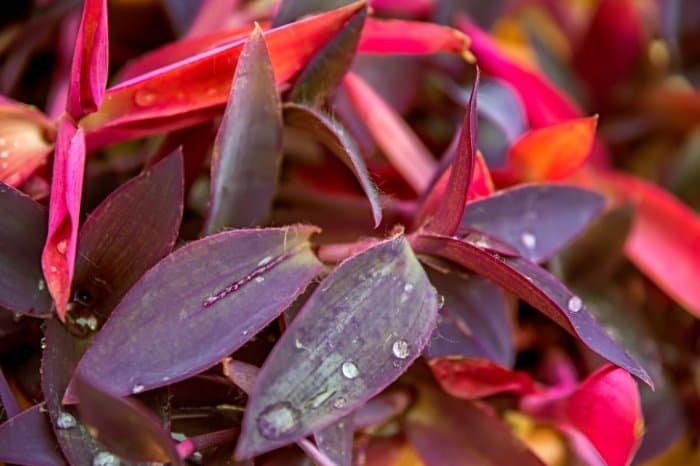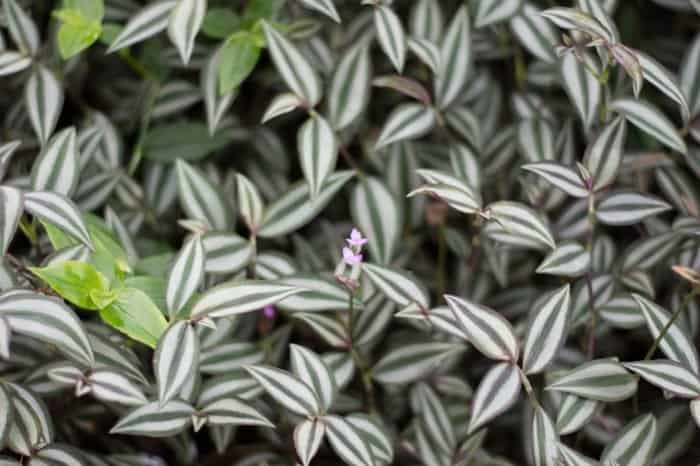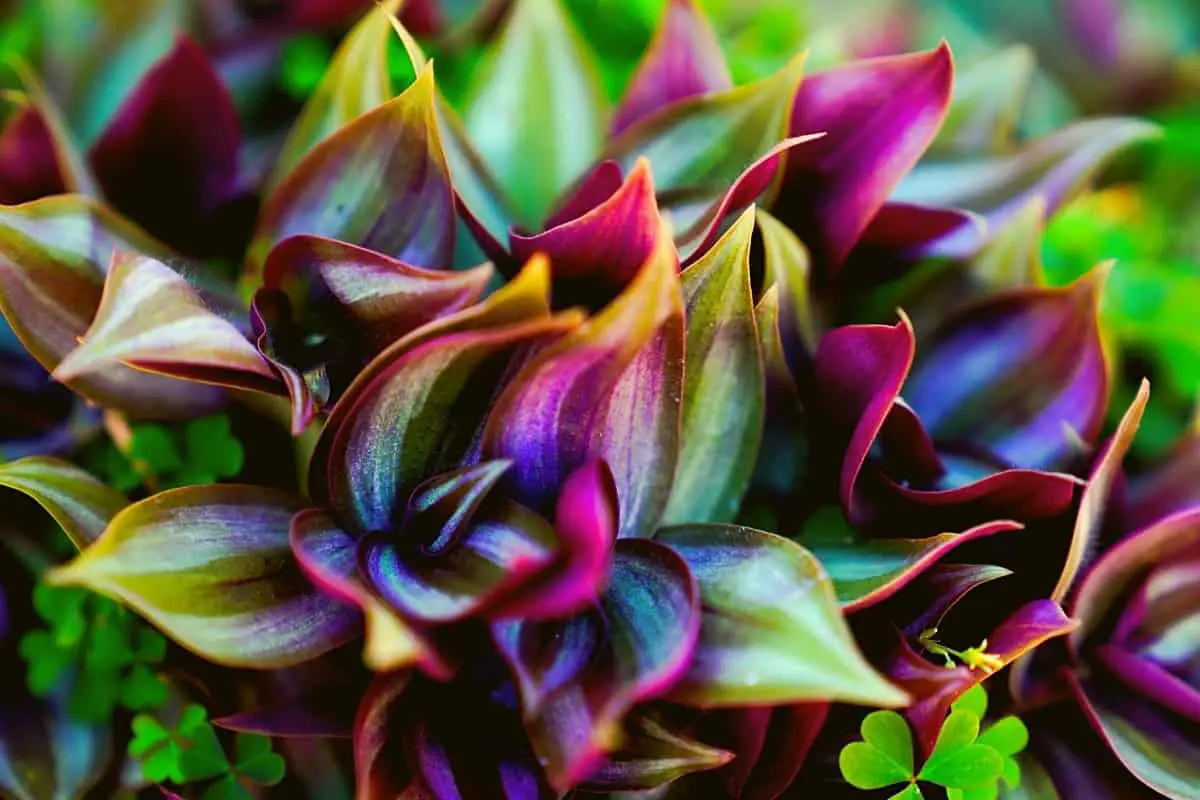Last Updated on January 20, 2022 by
There are many types of wandering Jew that you can grow on your farm depending on your favorite type and how to grow it, and the care it needs.
Wandering Jew is a plant that has plenty of versatility. It comprises various species in the Tradescantia genus. This plant is adaptable to both outdoor and indoor conditions. It doesn’t matter if you plant it on hanging baskets, ground cover, or containers, it does so well.
Did you know you can grow your wandering Jew in the complete shade as well as full sunlight? In full sun, the plant looks more colorful whereas under the shade it leaves a greenish hue.
Wandering Jew Plant Care Tips For All Types
There are some important care tips you ought to follow to make sure your wandering Jew is thriving. Here are some of them
- Grow your wandering Jew in bright, indirect sun or expose it to full sun – it will thrive in both conditions. Keep in mind that low light fades the markings on leaves.
- Water the plant directly around roots. Do not water the crown as it results in root rot. This plant prefers slightly moist soil, so maintain the right watering schedule.
- Fertilize your plants with an all-purpose, water-soluble fertilizer at least once a month during the growing period.
Let’s Look At The Types Of Wandering Jews You Should Consider
Tradescantia Zebrine
This type is one of the best types of wandering Jews topping this list. Its leaves resemble the stripes of a Zebra hence the name. The purplish-green foliage comes with a silver outer edge and white stripes running down lengthwise. It grows to a height of 6-12 inches and can successfully grow as ground cover.
Tradescantia Fluminesis
This is a popular houseplant that can also grow as ground cover. It has white beautiful flowers that are triangular formed by three petals. It has a magnificent look attached to the fleshy stems with oval-shaped leaves that are deep green and glossy.
Tradescantia Pallida Type
This type can grow in hanging baskets and as a ground cover. Purple Heart as its commonly known is native to Mexico. Its deep foliage has light purplish-pink flowers that look awesomely good. This type is also popular with many gardeners.

Tradescantia Blossfeldiana Type
This type is commonly known as the Inch Plant. Its thick green leaves have a fuzzy texture and a purple hue on the underside. You can easily grow this type from cuttings in both soil and water. It produces beautiful clusters of white flowers making it one of the best types of wandering Jew.
Tradescantia Spathacea
This type is also known as ‘Moses Basket, Boat Lily or Oyster Plant’. It is a sub-succulent herb from Guatemala, Southern Mexico, and Belize. It grows up to 6-12 inches long rosette and sword-like narrow spiral-shaped leaves. These dark-green leaves have purple bottom sides with white flowers with boat-like purple bracts.
Tradescantia Sillamontana
This type has beautiful foliage with geometric patterns. It grows from a thick succulent stem and the leaves are around 2 inches long covered entirely in white hair. Its magenta flowers bloom from the end of the stem during summer.
Osmocote Smart-Release Plant Food Plus Outdoor & Indoor, 8 lbs
Tradescantia Longipes
This plant produces purple-blue flowers that are three-petaled. This plant is native to Northern Arkansas to Southern Missouri from the family of Commelinaceae. Grow it in well-drained, moist, acidic soils. This type is one of the most popular types of wandering jew.
Tradescantia Navicularis
This type is known as Window’s Tears, Chain Plant, or Day flower. It is a creeping perennial succulent native to South America. This plant has the most beautiful narrow fleshy leaves that fold on opposite sides of the stem. It has bright lilac to magenta flowers that bloom in summer and lasts only a day. Like other types, this plant enjoys the indirect sun and well-drained soils. This type requires regular watering during the growing season
Tradescantia Fluminesis Variegata
This plant leaves range in shades of white to cream, to pale lemony white. The white parts won’t last long as they lack the ability to produce energy on their own. Simply remove them to allow new growth to take place. Remove the fully green parts that are close to the soil level to not take over the plant. This encourages the plant to keep looking its best.

FAQs
Where did the name wandering jew begin?
In the late 1800s, wandering Jew (Aegopodium podagraria) was a common name given to a species of perennial herb that was thought to have been introduced into Europe from North America. However, it is now believed that the plant probably originated in Eurasia, and was first found in Europe in the 19th century. The plant has since spread throughout the world as a garden escapee.
What is their scientific categorization?
They are all from the same family and genus. The species in this genus are all called Geranium. They have a flower that is shaped like a clover, and the flowers have five petals, and they are found all over the world. There are many different varieties of these plants, but they all look very similar.
Where do they come from?
Wandering Jews are a type of flowering plant in the genus Mimosa. The plant is native to the Americas and has been introduced to other areas around the world. In its natural environment it is found growing on the slopes of mountains, often near waterfalls.
How many types of wandering jews, or Tradescantia, are there?
Tradescantia is the common name for three species of plant, all of which are grown as ornamental plants. There are more than 20 different types of Tradescantia, ranging from the compact, bushy Tradescantia zebrina to the trailing Tradescantia coccinea. Tradescantia species grow well in many parts of the United States.
Tradescantia zebrina The common name for this species is “dwarf spiderwort” because its leaves look like small, web-like structures. In the summer, this plant produces many flower heads with a yellow center and a pale green ring of tiny flowers.
It grows in sandy or loamy soils in full sun. Tradescantia fluminensis This is one of the more common forms of Tradescantia, and is often found growing in moist areas. The leaves are dark green, and grow to be about 6 inches long.
The flowers are small and pale yellow. The flower is also a favorite of hummingbirds. Tradescantia fluminensis has been cultivated for hundreds of years.
Conclusion About Wandering Jew Flower
FAQs
Where did the name wandering jew begin?
In the late 1800s, wandering Jew (Aegopodium podagraria) was a common name given to a species of perennial herb that was thought to have been introduced into Europe from North America. However, it is now believed that the plant probably originated in Eurasia, and was first found in Europe in the 19th century. The plant has since spread throughout the world as a garden escapee.
What is their scientific categorization?
They are all from the same family and genus. The species in this genus are all called Geranium. They have a flower that is shaped like a clover, and the flowers have five petals, and they are found all over the world. There are many different varieties of these plants, but they all look very similar.
Where do they come from?
Wandering Jews are a type of flowering plant in the genus Mimosa. The plant is native to the Americas and has been introduced to other areas around the world. In its natural environment it is found growing on the slopes of mountains, often near waterfalls.
How many types of wandering jews, or Tradescantia, are there?
Tradescantia is the common name for three species of plant, all of which are grown as ornamental plants. There are more than 20 different types of Tradescantia, ranging from the compact, bushy Tradescantia zebrina to the trailing Tradescantia coccinea. Tradescantia species grow well in many parts of the United States.
Tradescantia zebrina The common name for this species is “dwarf spiderwort” because its leaves look like small, web-like structures. In the summer, this plant produces many flower heads with a yellow center and a pale green ring of tiny flowers.
It grows in sandy or loamy soils in full sun. Tradescantia fluminensis This is one of the more common forms of Tradescantia, and is often found growing in moist areas. The leaves are dark green, and grow to be about 6 inches long.
The flowers are small and pale yellow. The flower is also a favorite of hummingbirds. Tradescantia fluminensis has been cultivated for hundreds of years.
Having learned of all these types of wandering jew, you have a variety to chose from and opt for what to grow. These flowers are beautiful additions to your home or your garden. Their colored leaves and their bloom are amazingly beautiful and outstanding.
Caroline is a gardener who loves to get down to the nitty–gritty of gardening. She proudly proclaims herself as a ‘dirt worshipper‘ and can often be found deep in the garden, covered in soil and singing to her plants. As a self–proclaimed ‘plant whisperer‘, Caroline believes that plants need love and attention just like any other living thing, and she loves to give them both. When she‘s not tending to her garden, you can often find her researching the latest gardening trends, or teaching others how to make their gardens thrive


